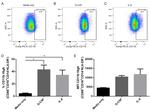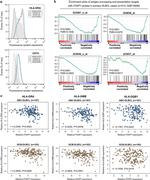Search Thermo Fisher Scientific
Invitrogen
HLA-DR Monoclonal Antibody (LN3), eVolve™ 605, eBioscience™
This Antibody was verified by Relative expression to ensure that the antibody binds to the antigen stated.
Product Details
83-9956-42
Published species
Host/Isotype
Class
Type
Clone
Conjugate
Form
Concentration
Storage conditions
Shipping conditions
RRID
Product Specific Information
Notice: The eVolve™ line of antibody conjugates will be discontinued at the end of February, 2018 and replaced with our improved Invitrogen™ eBioscience™ Super Bright conjugated antibodies for flow cytometry. Individual eVovle catalog numbers will become unavailable as inventory depletes. This item has a corresponding Super Bright 600 format available - please see Product # 63-9956-42. We will continue to offer a selection of Qdot conjugated antibodies.
Description: The LN3 mAb reacts with the human major histocompatibility complex (MHC) class II, HLA-DR. HLA-DR is expressed on the surface of human antigen presenting cells (APC) including B cells, monocytes, macrophages, DCs, and activated T cells. HLA-DR is a heterodimeric transmembrane protein composed of alpha and beta subunits and plays an important role in the presentation of peptides to CD4+ T lymphocytes.
Applications Reported: This LN3 antibody has been reported for use in flow cytometric analysis.
Applications Tested: This LN3 antibody has been pre-titrated and tested by flow cytometric analysis of normal human peripheral blood cells. This can be used at 5 µL per test. A test is defined as the amount of antibody that will stain a cell sample in a final volume of 100 µL. Cell number should be determined empirically but can range from 10^5 to 10^8 cells/test.
For best results when using antibodies conjugated to eVolve™, we recommend a quick spin of the vial before use and avoid touching the bottom of the vial with the pipet tip.
Laser/Filter Recommendation: eVolve™ 605 can be optimally excited with laser lines from 325-405 nm, and emits near 610 nm. We recommend using the violet (405 nm) laser line for excitation and a 595LP with a 605/40 or 610/20 bandpass filter, or equivalent, for detection.
Fixation Recommendation: Antibodies conjugated to eVolve™ are compatible with eBioscience's fixation and permeabilization buffers.
Excitation: 350-590 nm; Emission: 605 nm; Laser: Ultraviolet Laser, Violet Laser
Storage and handling: For best results when using antibodies conjugated to eVolve™, we recommend a quick spin of the vial before use and avoid touching the bottom of the vial with the pipet tip.
Target Information
HLA-DR, like other MHC class II molecules, is a transmembrane glycoprotein composed of a 36 kDa alpha chain (DRA) and 27 kDa beta chain (DRB). The alpha chain gene contains 5 exons. Exon 1 encodes the leader peptide, exons 2 and 3 encode the two extracellular domains, and exon 4 encodes the transmembrane domain and the cytoplasmic tail. DRA does not have polymorphisms in the peptide binding part and acts as the sole alpha chain for DRB1, DRB3, DRB4 and DRB5. Within the DR molecule the beta chain contains all the polymorphisms specifying the peptide binding specificities. Hundreds of DRB1 alleles have been described and typing for these polymorphisms is routinely done for bone marrow and kidney transplantation. HLA-DR is expressed primarily on antigen presenting cells such as B lymphocytes, monocytes, macrophages, thymic epithelial cells and activated T lymphocytes. Three loci, DR, DQ and DP, encode the major expressed products of the human class II region. The human MHC class II molecules bind intracellularly processed peptides, present them to T-helper cells, and have a critical role in the initiation of the immune response.
HLA and MHC antibodies play a significant role in Immunopeptidomics, facilitating the identification and characterization of neoantigens through high-performance liquid chromatography coupled to tandem Mass Spectrometry.
For Research Use Only. Not for use in diagnostic procedures. Not for resale without express authorization.

Performance Guarantee
If an Invitrogen™ antibody doesn't perform as described on our website or datasheet,we'll replace the product at no cost to you, or provide you with a credit for a future purchase.*
Learn more
We're here to help
Get expert recommendations for common problems or connect directly with an on staff expert for technical assistance related to applications, equipment and general product use.
Contact tech support
























